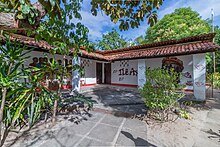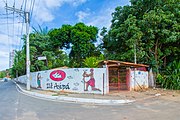| Ilé Axé Asìpá | |
|---|---|
 | |
| Religion | |
| Affiliation | Candomblé |
| Location | |
| Municipality | Salvador |
| State | Bahia |
| Country | Brazil |
| Geographic coordinates | 12°56′18″S 38°22′53″W / 12.938309°S 38.381452°W / -12.938309; -38.381452 |
| Architecture | |
| Creator | Deoscoredes Maximiliano dos Santos (Maestre Didi) |
| Completed | 1980 |
Ilé Axé Asìpá, also known as the Sociedade Cultural e Religiosa Ilê Axipá is an Afro-Brazilian terreiro in Salvador, Bahia, Brazil. It was founded by Descoscoredes Maximiliano dos Santos (1917–2013), commonly known as Maestre Didi, in 1980. Ilé Axé Asìpá is dedicated to the worship of egum or male ancestors, in contrast to Candomblé terreiros dedicated to the worship of orixás, or deities of the Yoruba pantheon. Terreiros dedicated to egum appeared in Brazil in the early 19th century, largely by slaves associated with the city of Oyo in Nigeria. The chief priest in an egum terreiro is known as a Ojé or Babá Ojé. The hierarchy of egum terreiros is strictly patriarchal; unlike Candomblé temples, women are not initiated into leadership roles.
While dedicated to the worship of egum, Ilê Axipá is associated with the Ketu sect of Candomblé.
History


Ilê Axipá is located on Rua da Gratidão in the Piatã neighborhood of Salvador at the margins of Paz neighborhood. The ethnologist Maria Gabriela Hita noted that despite the stature of Mestre Didi and visits by prominent figures in Bahian society, the terreiro has few followers in the neighborhood and has not participated in its urban renewal or other social movements.
Lineage
- Maestre Didi (1980–2013)
Protected status
The Institute of Artistic and Cultural Heritage of Bahia listed the Ilé Axé Asìpá as a state heritage site in 2017.
References
- ^ "Mestre Didi: documentário e tombamento do Ilê Axé Asipá celebram centenário". Correio (in Portuguese). 27 November 2017. Wikidata Q124302028.
- Dunn, Christopher (2002). "Didi". Encyclopedia of Contemporary Latin American and Caribbean Cultures. Routledge. p. 492. ISBN 9781134788514.
- Pereira, Rodrigo (2014). "Por uma outra diáspora: formação histórica e dispersão dos terreiros de Candomblé no Grande Rio". Revista de História Bilros:. História(s), Sociedade(s) e Cultura(s). 2 (3): 139.
- Hita, Maria Gabriela. "Da avenida resistencia à praça das decisões: novos atores urbanos em Salvador-Bahia" (PDF) (in Portuguese). Retrieved 2017-06-21.